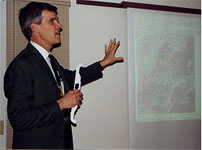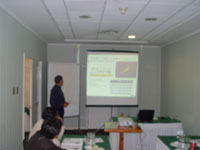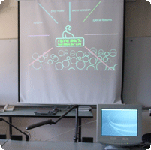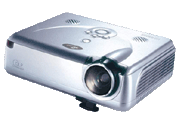|
|
You are going to listen to an interview with Matt Gerrard, chief consultant at Technical Business Solutions based in Brussels, Belgium. |
![]() Before you
listen to expert Matt Gerrard, see how much you know about presentations by
answering the following true or false questions.
Before you
listen to expert Matt Gerrard, see how much you know about presentations by
answering the following true or false questions.
![]()
| 1. The four main reasons people give presentations are to sell, entertain, persuade and pass information. | |
| 2. The secret to giving a successful presentation is preparation. | |
| 3. It’s important to know what time of day you are going to give your presentation. | |
| 4. ‘Visual aids’ can be anything that helps you to make your presentation clear to the audience. | |
| 5. Most presentations are in four parts. | |
| 6. It’s better to read your presentation that be completely spontaneous. | |
| 7. It’s a good idea to practise in front of a mirror. |
![]()
![]()
 Now listen to the interview and
Now listen to the interview and
![]() check your answers.
check your answers.
![]() Here are
some of the questions that Matt suggests you ask yourself before you give a
presentation. The words are in the wrong order. Write the words in the correct
order. Follow the example.
Here are
some of the questions that Matt suggests you ask yourself before you give a
presentation. The words are in the wrong order. Write the words in the correct
order. Follow the example.
| Example: making why I presentation this am? |
|
1. to making am I this who presentation
2. presentation am where I making this? 3. I this when presentation am making? 4. be long will how it? 5. should presentation I make this how? 6. say what I should? |
 |
![]()
 Now listen and
Now listen and
![]() check your answers.
check your answers.
![]()
 Listen and repeat the questions.
Listen and repeat the questions.
![]()
 Listen to the interview again and complete the following transcription. Use
the pause button on your media player to give you time to write, and listen
as many times as necessary.
Listen to the interview again and complete the following transcription. Use
the pause button on your media player to give you time to write, and listen
as many times as necessary.
![]()
| Matt, lets
start by asking you for your definition of a presentation. A presentation is a formal talk to one or more people that "presents" ideas or information in a clear, structured way. All presentations have a . People give presentations because they want to communicate something. It could be to inform, train, persuade or sell something. Business people often get so nervous when they
have to give a presentation, don’t they Matt? So, what’s the most important thing when giving a presentation, Matt ? By far the most important thing is preparation. That’s the secret to giving a successful presentation. With good preparation and planning you will be totally and less . And your audience will feel your confidence. It’s important to take control of your presentation. With control your audience will to your message. That makes a lot of sense Matt. So, how should we begin our preparation? Well, I like to start by asking myself some
questions: What sort of things would you include in visual aids, Matt? Well, maps, photos, diagrams, charts, power point
slides etc. Anything visual that could help you
. I see. Then I think about the structure of my presentation. A well organised presentation with a clear structure is easier for the audience to follow. It is therefore more effective. You should organise the points you wish to make in a . Most presentations are organised in three parts, followed by questions at the end. So, everything is very organised and clear before you start? Exactly Sue! however, when you give your presentation, you should be, or appear to be, as as possible. Don’t make the mistake of reading your presentation. You should be so familiar with your subject that you do not need to read a text. Reading a text is and will probably make your audience go to sleep! But just a second Matt, if you don't have a text to read, how can you remember to say everything you need to say? With notes. You can create your own system of notes. Some people make notes on . Some people write down just the title of each section of their talk. Some people write down keywords to remind them. The notes will give you , but because you will have prepared your presentation fully, you may not even need them! And I suppose you would need to practise a lot before you give your presentation?
So, preparation is the key then Matt? Absolutely. Prepare, prepare, prepare! Prepare everything: words, visual aids, timing, equipment. Rehearse your presentation several times and time it. Is it the right ? Are you completely familiar with all your illustrations? Are they in the ? Do you know who the audience is? How many people? How will you answer difficult questions? Do you know the room? Are you confident about the ? When you have answered all these questions, you will be a confident, enthusiastic presenter ready to communicate the subject of your presentation to your audience. Matt, thank you very much for your time. You’re more than welcome, Sue. |
|
|
|
|
La Mansión del Inglés. https://www.mansioningles.com
© Copyright La Mansión del Inglés C.B. Todos los derechos reservados.



 Yes,
that’s right Sue, people are sometimes
of speaking in public, but if you
follow a few simple rules, giving a presentation is actually very easy.
Yes,
that’s right Sue, people are sometimes
of speaking in public, but if you
follow a few simple rules, giving a presentation is actually very easy.
 Secondly, Who am I making this presentation to? Sometimes this will be
obvious, but not always. So find out as much information as possible about
your audience. How many people? Who are they? Are they business people?
Professional people? Political people? Experts or non-experts? Will it be
a small, intimate group of 4 or a
large room of 400 ? How much do
they know already and what will they expect from me?
Secondly, Who am I making this presentation to? Sometimes this will be
obvious, but not always. So find out as much information as possible about
your audience. How many people? Who are they? Are they business people?
Professional people? Political people? Experts or non-experts? Will it be
a small, intimate group of 4 or a
large room of 400 ? How much do
they know already and what will they expect from me?
 Yes
indeed. Rehearsal is a vital part of preparation. You should leave time to
practise your presentation two or three times, in front of a mirror if
possible. This will make you more familiar with what you want to say, help
you to
in your presentation and to practise difficult pronunciations. You will
also be able to check the time that your presentation takes and make any
necessary changes and . You could
even practise in front of your family or friends.
Yes
indeed. Rehearsal is a vital part of preparation. You should leave time to
practise your presentation two or three times, in front of a mirror if
possible. This will make you more familiar with what you want to say, help
you to
in your presentation and to practise difficult pronunciations. You will
also be able to check the time that your presentation takes and make any
necessary changes and . You could
even practise in front of your family or friends.